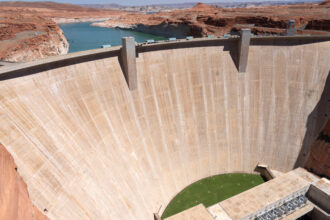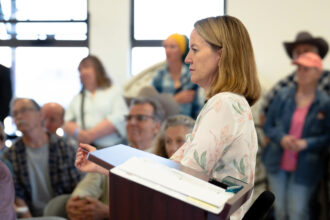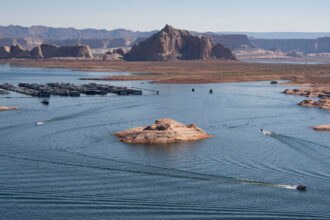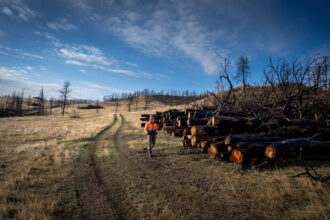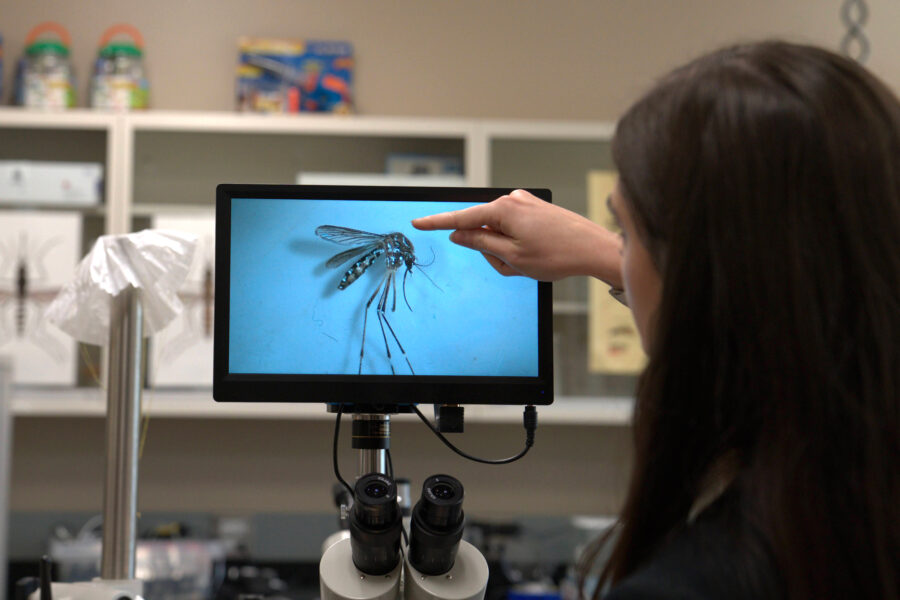CAMP VERDE, Ariz.—In front of Buddy Rocha Jr. stood a group of Arizona’s local and state-level politicians, agency staffers and water experts. Behind the Yavapai-Apache chairman flowed the Verde River.
For centuries, he said, his people have depended on the land along the 193-mile waterway—from its headwaters to the lower stretch that is designated now as a National Wild and Scenic River.
Rocha grew up here in the Verde Valley playing and fishing in the river.
“It’s a part of me,” he said. “It’s a part of my people.”
That is why it is so important to protect every drop of the Verde River, he explained. The three sewage lagoons sitting in the floodplain on the other side of the river are an outdated eyesore, he said, and “irresponsible” given they are in a 100-year-flood zone.
“You can go back to Roman times, and they utilized those systems,” he said, “and we’re still using them today.”
By mid-2027, that will change, with the sewer lagoons replaced by a water reclamation facility that will protect water quality and save millions of gallons each year by treating wastewater to irrigate crops, thus conserving drinking water. But doing so won’t come cheap—the first phase of the project will cost $40 million, the funds coming from the tribe, the U.S. Army Corps of Engineers and Arizona’s Water Infrastructure Financing Authority, better known as WIFA.
It’s a small price to pay to conserve water in a 193-mile river that supplies the Verde Valley and the Phoenix metropolitan area. Local leaders and water experts say the project and others like it will be essential to safeguarding Arizona’s communities and ensuring their future as the state and Southwest face a decades-long drought that is cutting supplies.
But the money to continue projects like this has dried up. Arizona passed a bill in 2022 setting aside $1 billion for water-related projects, which was to be spent over three years. All of that money that was earmarked for conservation, over $200 million, has been spent, and as the state’s budget has diminished, it has cut back WIFA’s funding.
Arizona’s water problems, however, are far from over, with the state likely facing substantial cuts to its share of the Colorado River and the overdrafting of many of its aquifers. The message from Rocha, other community leaders and water experts is clear: every drop counts, and conserving water requires funding and collaboration.
“We’re going to have less water from the Colorado River,” said Haley Paul, the Arizona policy director for Audubon Southwest, which helped arrange a tour to water conservation project sites in the Verde Valley. “We don’t know how much yet, but we can all accept that there’s going to be less.
With no new supplies available, “it’s more vital than ever that we make sure the water supplies that we do have—like the Salt River, like the Verde River, like our groundwater supplies—are treated with care because we’re going to be relying on them more,” she said.
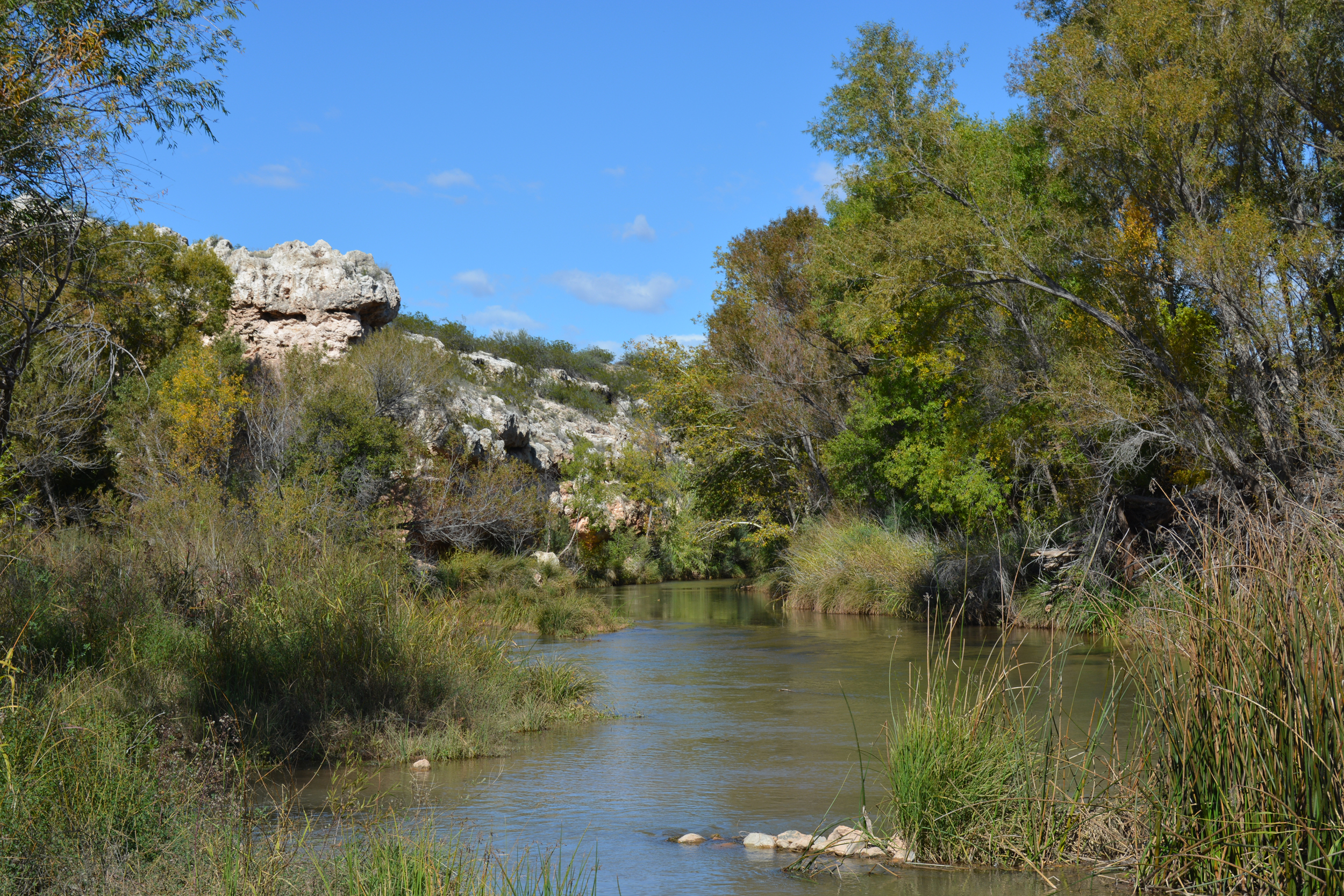
The water reclamation project that is replacing the sewage lagoons on the Yavapai-Apache nation is just one of over 200 water conservation projects WIFA has helped fund in recent years throughout Arizona. Across the Verde Valley, communities are constructing similar projects: Camp Verde is installing new meters to monitor water use and leaks; Clarkdale is replacing its water pipelines, which once leaked 40 percent of its water, and expanding its arsenic treatment facility and increasing its water storage capacity; the local irrigation system for the region’s farms is installing pipes in irrigation ditches to save water.
Since 2023, WIFA water conservation projects that have saved an estimated 6,500,000 acre-feet of water. One acre-foot is enough to supply three homes with water for a year.
There is no shortage of demand for funding, said Judah Waxelbaum, WIFA’s chief of government affairs. Initial applications in 2023 for funding from the water conservation pool totaled over $300 million, $100 million more than what was budgeted. A second round with $14 million of available funding in February got $80 million worth of applications. On top of the millions for conservation, 75 percent of the funding was slated to find an out-of-the-state water solution, such as desalinating ocean water or wastewater reclamation, but exact details have yet to be released to the public.
But the 2024 state budget signed by Gov. Katie Hobbs cut funding for WIFA by nearly $500 million, a response to Arizona’s funding shortfall due to a tax cut and a school voucher program passed by Hobbs’ predecessor. The bill signed by former Gov. Doug Ducey in 2022 allowing WIFA to expand its operations allocated more than $1 billion to fund three years’ worth of work to augment and preserve water supplies in Arizona.
Last year WIFA requested $25 million, Waxelbaum said, and ended up getting just $250,000. Their ask is simpler this year: Don’t cut the long-term fund to find an out-of-state water supply.
While it may be hard for some to see the long-term value in letting money sit in the fund, he said, it is a signal to the private market that the state is serious about the investment and gives WIFA leverage. And it’s clear the market for finding water is there, with cities shelling out tens of millions of dollars for small amounts of groundwater to make way for more housing in the Phoenix area.
“These are generational ideas and investments,” Paul said. These outlays of funding, as well as continued work to settle tribal water rights, work out allocations from the state’s rivers that haven’t been adjudicated and regulate Arizona’s groundwater, need to continue, she said.
Inaction will threaten the state’s rapid growth and economy, as well as Arizona’s famed landscapes. Already, some communities have seen their wells go dry. It’s a commitment, too, to showing the rest of the West that Arizona is taking water conservation seriously—messaging that may be vital for the future of the Colorado River as states in its upper and lower basins argue over how to distribute its diminishing supply of water and fears run high that the disputes may end up in the courts.
“Painful Decisions”
Aridification brought on by climate change along with the overconsumption of aquifers and rivers has forced Arizona and the Southwest to confront a future with less water.
The seven Colorado River Basin states—Arizona, California, Colorado, Nevada, New Mexico, Utah and Wyoming—are engaged in tense negotiations over how to manage the declining river. Meanwhile, much of rural Arizona has gone decades without any form of groundwater management, and in many cases, how much water well owners pump out of an aquifer is completely unknown. Some large water consumers, largely agricultural operations, which use the vast majority of the state’s water, have exploited the lack of monitoring and regulation to pump so much that residential wells have run dry in parts of the state.
And even where groundwater is regulated, supplies are running out, with the Phoenix area sucking up so much water from its aquifers that the state is allowing no further development relying solely on wellwater.
“We have to come to terms with the fact that we just don’t have the water that we used to have,” said Jay Famiglietti, science director for Arizona State University’s Arizona Water Innovation Initiative. “We have a growing population. We need to grow more food. We still want to pursue economic growth. We just can’t do everything anymore, and so there will have to be painful decisions that are made.”
Famiglietti co-authored two major groundwater studies this year. The first found that in the Colorado River Basin, groundwater decline is outpacing the losses of the river’s water. The other found that globally, aquifers are in steep decline, so much so that the pumping of groundwater hidden deep below the ground is now a leading cause of sea level rise when it drains into the ocean.
Confronting Arizona’s declining water supplies has been a top priority for Gov. Hobbs, a Democrat, but with Republicans controlling the Arizona House of Representatives and Senate, progress has been challenging. In three years in office, the biggest groundwater legislation passed was a bill that will allow for agricultural producers to sell their rights to cities, dubbed the “Ag-to-Urban” program.
“We have to come to terms with the fact that we just don’t have the water that we used to have.”
— Jay Famiglietti, Arizona Water Innovation Initiative
It’s an important step, Famiglietti and Paul said, though more work needs to be done. The program, some have argued, won’t save water, but put it to use in what the market determines best fuels the Phoenix area’s economy and rapid growth.
But updating the state’s groundwater laws to give rural communities a framework to manage their supplies has stalled for years, even when Republican state legislators introduced bills with bipartisan support to do so or when rural community leaders consistently ask for such regulations.
That’s led Hobbs and the Arizona Department of Water Resources to take matters into their own hands by introducing an Active Management Area (AMA) in Willcox, east of Tucson, and is considering doing so elsewhere.
As Wells Run Dry, Rural Residents Call for More Regulation
Cochise County is home to Willcox, the epicenter of Arizona’s groundwater crisis.
Here, the Sonoran desert turns green with massive industrial agricultural operations. Miles of alfalfa fields and pecan and apple trees cover the landscape so that it’s easy to forget this is a desert. But there is no river, or any surface water, to feed the crops, which instead rely on water from beneath the ground.
Evidence of the aquifer’s collapse has begun to show—signs along the highway warn of fissures in the earth, and area homeowners’ wells have gone dry. Data from the Arizona Department of Water Resources found the aquifer has been drawn down 400 feet below the average well depth. Between 1940 and 2015, 5.7 million acre feet of water has been sucked from the ground, nearly double the amount that the state gets from the Colorado River in wet years and enough for nearly 15 million homes. In 2022, 108,428 acre-feet more water was pumped out of the aquifer than was replenished by rain or other sources, about the same amount of water Tucson uses each year.
“The groundwater is disappearing,” said ASU’s Famiglietti. “It’s one of the most heavily pumped regions of the state. The ground is cracking. It’s sinking. It just can’t go on like that.”
“We’ve had a good run, but we have to be thinking about the future,” he added. “I’m fully supportive, of course, of agriculture. We have to grow food. We have to eat, but we have to do it for generations, not just for this generation.”
For years, homeowners and smaller farmers have called for action, eventually culminating in the state beginning the process to implement the AMA around Willcox late last year, with a goal of reducing the overdrafting of groundwater by at least 50 percent by 2075. But for some, that’s not enough.
On a cloudy, gray day, but one that would yield no rain, residents gathered in Sierra Vista, outside of the Cochise County Republican Committee headquarters for a protest. Late summer is Arizona’s monsoon season, when late afternoons bring dark clouds, massive dust storms and, on occasion, nearly the entire year’s worth of rain in one or two monster storms.
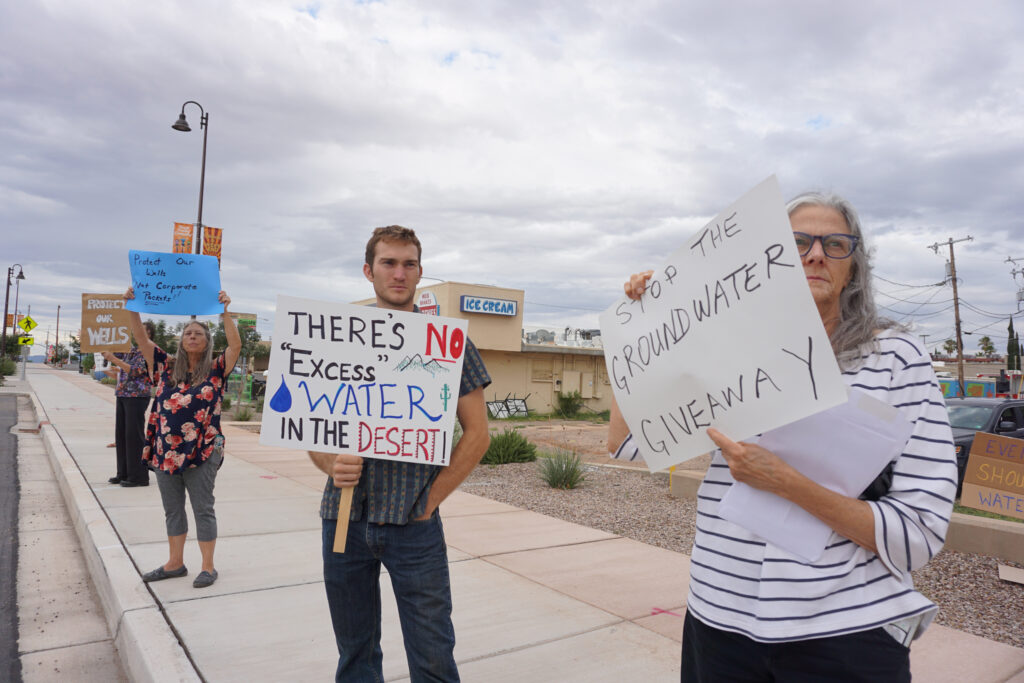
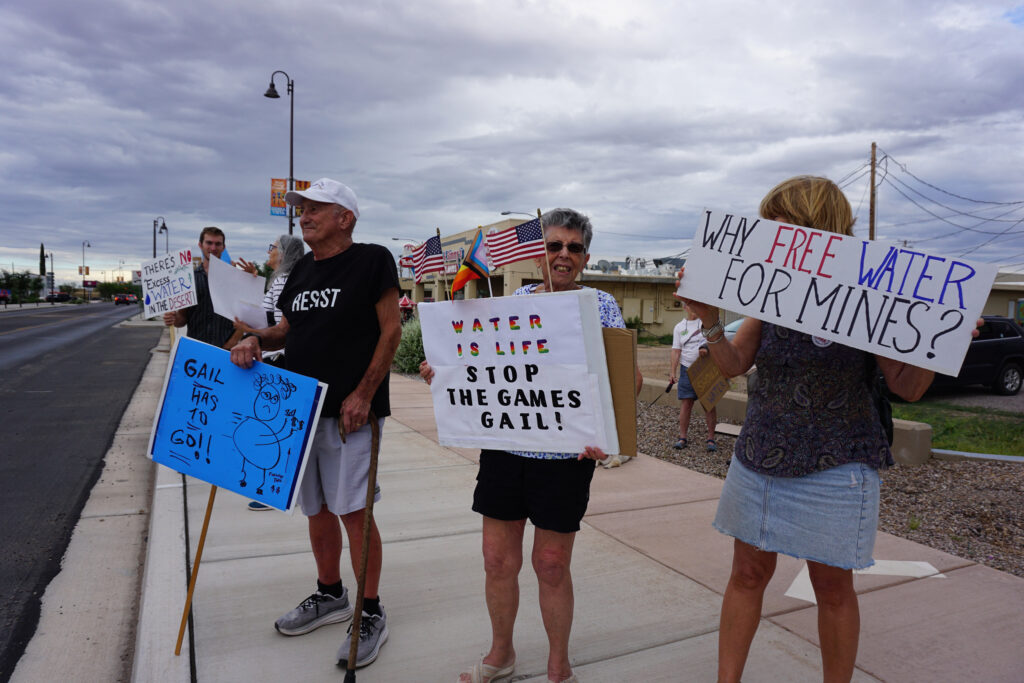
Locals from across Southern Arizona gather for a rally for groundwater protection in rural parts of the state on Aug. 27 in Sierra Vista, Ariz. Credit: Courtesy
They were there to protest a Water 101 presentation by the committee, led by Arizona House Rep. Gail Griffin, who chairs the state’s water and land use committees. Local leaders and environmentalists have long seen Griffin as an obstacle to rural groundwater management who has prevented bipartisan bills to address the issue from reaching the House floor for a hearing.
“Gail is an obstruction to anything she doesn’t like,” said Tricia Gerrodette, a Sierra Vista resident at the protest who has for years advocated to protect groundwater and the local San Pedro River.
Kathy Carter and Lisa Glenn have lived in the Willcox area for decades and watched as the aquifer declined after a massive out-of-state dairy operation, Riverview LLP, moved into the area. Between 2023 and 2024, Carter said, measurements from the state water department showed her home’s well levels had dropped two feet.
“We are trying to counter the misinformation that is being put out” about what the region is facing, Glenn said, and let the community know that Griffin “has deliberately kept every chance of regulation” of rural groundwater from moving forward.
In a recent editorial in the Gila Herald, Griffin wrote that “Arizona is often portrayed as a state on the brink of a water crisis. Yet few realize that more than 90 percent of Arizonans already live under some form of groundwater management.”
The state already “has every tool it needs to protect local supplies where science and residents support it,” she wrote, and should focus on using its current regulations most effectively. Urban areas where most people live already have regulations, she wrote.
The column, however, makes no mention of the groundwater issues rural Arizona communities have faced.
This story is funded by readers like you.
Our nonprofit newsroom provides award-winning climate coverage free of charge and advertising. We rely on donations from readers like you to keep going. Please donate now to support our work.
Donate NowGlenn called the editorial “a whitewash of mish-mash.”
“For pity’s sake, I think we all know we’re way past being portrayed as on the brink of a water crisis,” she said.
“When the water goes … we will have lost a very valuable and wonderful environment here,” she added. “Time and scale will do us all in if we don’t get a handle on it.”
Action Within the State Won’t Be Enough
The state may not have all the legal tools it needs to address the issue across the state, but the governor and water department are using what they can.
On Nov. 5, Hobbs announced the state would be initiating an AMA in Ranegras Plain Groundwater Basin, found in La Paz County on the state’s Western border, where groundwater pumping for a controversial alfalfa operation has drained the aquifer and dried up wells. There, a Saudi Arabian-owned company, Fondomonte, has used 90 percent of the basin’s water.
“It is unacceptable that for decades legislators have refused to protect rural communities and their cries for help have gone unheard,” Hobbs said in a press release announcing the AMA formation. “It’s time to put Arizonans first and protect our water from corporate interests profiting at our expense.”
La Paz County Supervisor Holly Irwin, who has fought for years to enact groundwater regulation in rural parts of the state, applauded the governor’s efforts “to protect these groundwater basins with the statutory tools she has when the legislature has failed for years to help our communities.”
Local rancher Boyce Andersen said the AMA means “means that our state leaders are listening and looking for ways to protect the water supplies of our farmers and ranchers in rural Arizona.”
And Pastor Carroll E. Miles of The Fellowship Baptist Church of Vicksburg, which had its well go dry due to Fondomonte’s operations nearby, creating a cone of depression in the aquifer, said “small communities like ours have been at the mercy of out-of-state, corporate interests that come to rural Arizona to exploit our water supplies at our expense. This issue has been ignored for far too long, and I’m grateful that ADWR and the governor are taking steps to put in place the protections that we need.”
But the fight for Arizona’s water future won’t end with actions within the state. The same day that Hobbs announced the new AMA, she criticized Upper Colorado River Basin states positions in the current negotiations over management of the river in a speech before the National Water Resources Association Meeting Leadership Forum.
“After years of negotiations and meeting after meeting after meeting, and time running short to cut a deal, we have yet to see any offer or real, verifiable plan to conserve water from the four Upper Basin States who rely upon this shrinking river,” Hobbs said, according to the Arizona Daily Star.
Arizona, California and Nevada have committed to real cuts, she said, but not the Upper Basin, whose position to manage the Colorado River is an “unacceptable outcome for Arizona families, farmers and businesses.”
“This is the extreme negotiating position we are confronted with as the Upper Basin states, led by Colorado, continue to run down the clock,” Hobbs said. “As we approach critical deadlines, we need the Trump administration to step in, exert leadership and broker a deal.”
About This Story
Perhaps you noticed: This story, like all the news we publish, is free to read. That’s because Inside Climate News is a 501c3 nonprofit organization. We do not charge a subscription fee, lock our news behind a paywall, or clutter our website with ads. We make our news on climate and the environment freely available to you and anyone who wants it.
That’s not all. We also share our news for free with scores of other media organizations around the country. Many of them can’t afford to do environmental journalism of their own. We’ve built bureaus from coast to coast to report local stories, collaborate with local newsrooms and co-publish articles so that this vital work is shared as widely as possible.
Two of us launched ICN in 2007. Six years later we earned a Pulitzer Prize for National Reporting, and now we run the oldest and largest dedicated climate newsroom in the nation. We tell the story in all its complexity. We hold polluters accountable. We expose environmental injustice. We debunk misinformation. We scrutinize solutions and inspire action.
Donations from readers like you fund every aspect of what we do. If you don’t already, will you support our ongoing work, our reporting on the biggest crisis facing our planet, and help us reach even more readers in more places?
Please take a moment to make a tax-deductible donation. Every one of them makes a difference.
Thank you,







